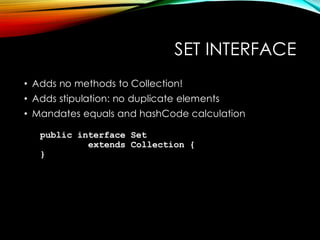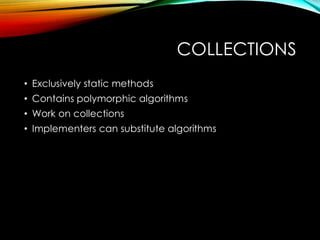Data Structures in Java and Introduction to Collection Framework
- 1. DATA STRUCTURES IN JAVA Arun Seetharaman March 10, 1998
- 2. TOPIC OBJECTIVES • Understand some useful data structures in the java.util package • The Observer-Observable pattern • Java Collection Framework • Iterators
- 3. DATA STRUCTURES • Well designed java.util package • A bunch of dynamic data structures • You do not have to write linked lists and hash tables • Could be building blocks for more complicated data structures
- 4. THE “VECTOR” CLASS • A very generic structure for storing and retrieving objects • A very simple structure to use • Tries to optimize storage, resulting in some extra capacity at times • Removal of elements closes the holes created
- 5. VECTOR OPERATIONS public void addElement(Object); public void clear(); public Object elementAt(int); public void insertElementAt( Object, int); public void removeElementAt(int); public void setElementAt( Object, int); public int size();
- 6. THE “HASHTABLE” CLASS • Useful for searchable data structures • Stores key-value pairs • Key-based search mechanism • Better than Vector for large amount of data that need to be searched public Object get(Object); public Object put(Object,Object); protected void rehash();
- 7. CALENDARS • Date: mostly deprecated as of JDK1.1 • Calendar: Convert Date objects to fields • GregorianCalendar: Important class that cater to the differences between Julian date and Gregorian date. Also understands timezones • TimeZone: represents any timezone with the GMT offset
- 8. THE BITSET CLASS • Represents a collection of bits • Grows dynamically as bits are required • Bits accessed using 0-based index • public void and(BitSet); • public void andNot(BitSet); • public void or(BitSet); • public void xor(BitSet);
- 9. OBSERVER-OBSERVABLE PATTERN • Update multiple objects from a common source of data • Displaying data in multiple formats like charts, worksheet is a common example • More often implemented using the MVC design pattern
- 10. THE “OBSERVABLE” CLASS • Represents the data source • Can have one or more observers void addObserver(Observer); void deletebserver(Observer); void notifyObservers(Object); void setChanged(); boolean hasChanged(); void clearChanged();
- 11. AN OBSERVABLE ENTITY class MsgObservable extends Observable implements Runnable { public void run() { while(true) { msg = waitForMsg(); setChanged(); notifyObservers(msg); } } }
- 12. THE “OBSERVER” INTERFACE • Implemented when changes in an “Observable” object need to be informed • update is invoked, when the Observable object calls the notifyObservers method class LogServer implements Observer { public void update(Observable obs, Object obj) { logTheMsg(obj); } }
- 13. WHAT IS A COLLECTION FRAMEWORK? • Unified Architecture • Interfaces : implementation-independence • Implementations : reusable data structures • Algorithms : reusable functionality • Best-known examples • C++ Standard Template Library (STL) • Smalltalk
- 14. ARCHITECTURE OVERVIEW • Core Collection Interfaces • General-Purpose Implementations • Wrapper Implementations • Abstract Implementations • Algorithms
- 16. COLLECTION INTERFACE public interface Collection { int size(); boolean isEmpty(); boolean contains(Object element); Iterator iterator(); Object[] toArray(); Object[] toArray(Object a[]); }
- 17. ITERATOR INTERFACE • Replacement for Enumeration interface • Adds remove method • Improves method names public interface Iterator { boolean hasNext(); Object next(); void remove(); // Optional }
- 18. COLLECTION EXAMPLE public static boolean removeNulls( Collection c) { boolean modified = false; for (Iterator i=c.iterator();i.hasNext();){ if (i.next()==null) { i.remove(); modified = true; } } return modified; }
- 19. SET INTERFACE • Adds no methods to Collection! • Adds stipulation: no duplicate elements • Mandates equals and hashCode calculation public interface Set extends Collection { }
- 20. SET IDIOMS Set s1, s2; boolean subset = s1.containsAll(s2); Set union = new HashSet(s1).addAll(s2); Set intersection = new HashSet(s1).retainAll(s2); Set difference = new HashSet(s1).removeAll(s2);
- 21. LIST INTERFACE • A sequence of objects public interface List extends Collection { Object get(int); int lastIndexOf(Object); int lastIndexOf(Object, int); ListIterator listIterator(int); … }
- 22. LIST EXAMPLE • Reusable algorithms to swap elements and randomize public static void swap(List a, int i, int j) { Object tmp = a.get(i); a.set(i, a.get(j)); a.set(j, tmp); } public static void randomize(List a) { for (int i=a.size(); i>1; i--) swap(a, i-1, (r.nextInt() &~ (1<<31)) % i); }
- 23. MAP INTERFACE • A key-value mapping public interface Map { int size(); boolean isEmpty(); boolean containsKey(Object key); boolean containsValue(Object value); Object get(Object key); public Set keySet(); public Collection values(); public Set entries(); }
- 24. MAP IDIOMS Map m; for (iterator i=m.keySet().iterator(); i.hasNext(); ) System.out.println(i.next()); Map a, b; boolean isSubMap = a.entries().containsAll(b.entries()); Set commonKeys = new HashSet(a.keySet()).retainAll(b.keySet);
- 26. COLLECTIONS • Exclusively static methods • Contains polymorphic algorithms • Work on collections • Implementers can substitute algorithms
- 27. SYNCHRONIZATION WRAPPERS • Anonymous implementations, one per core interface • Static factories take collection of appropriate type • Thread-safety assured if all access via wrapper • Iteration must be synchronized manually
- 28. SYNCHRONIZATION WRAPPER EXAMPLE Set s = Collections.synchronizedSet( newHashSet()); ...s.add("wombat"); // Thread-safe ... synchronized(s) { Iterator i = s.iterator(); // In synch block! while (i.hasNext()) System.out.println(i.next()); }
- 29. UNMODIFIABLE WRAPPERS • Unmodifiable wrappers • Analogous to synchronization wrappers • Provide read-only access • Available for core interfaces
- 30. CONVENIENCE WRAPPERS • List-view of arrays • Multiple-copy list • Singletons • Empty collections
- 31. SOME NEEDS FOR CUSTOMIZATION • Persistence • Highly concurrent collections • High-performance, special-purpose • Space-efficient representations • Fancy data structures • Convenience classes
- 32. REUSABLE ALGORITHMS • Sorting • Searching • Shuffling • Data Manipulation • Extreme Values
- 33. ALGORITHMS: SORTING • Uses an optimized merge sort • Doesn’t reorder equal elements • static void sort(List); • static void sort(List, Comparator);
- 34. COMPARABLE AND COMPARATOR • Comparable: uses the natural ordering for that object type • int compareTo(Object); • Comparator: can define custom ordering for object • int compare(Object, Object); • boolean equals(Object);
- 35. ALGORITHMS: SEARCHING • Works on sorted lists • Uses the binary search algorithm • int binarySearch(List, Object); • int binarySearch(List, Object, Comparator);
- 36. ALGORITHMS: SHUFFLING • Force randomness in the Collection • A random object defines the randomness for the shuffle operation • void shuffle(List); • void shuffle(List, Random);
- 37. OTHER ALGORITHMS • Data Manipulation: • void copy(List, List); • void fill(List, Object); • void reverse(List); • Extreme Values: • Object max/min(Collection); • Object max/min(Collection, Comparator);
- 38. COMPATIBILITY • Upward Compatibility • Vector implements List • Hashtable implements Map • Arrays.toList(myArray) • Backward Compatibility • myCollection.toArray() • Vector(myCollection) • Hashtable(myMap)
- 39. TOPIC SUMMARY • The java.util package has a good collection of data structures • Classes to support the Observer-Observable pattern • Collection framework for improved data structures • Many reusable algorithms implemented


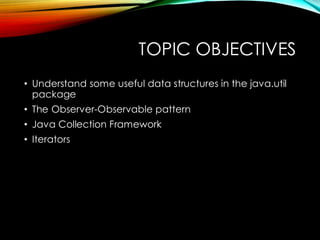
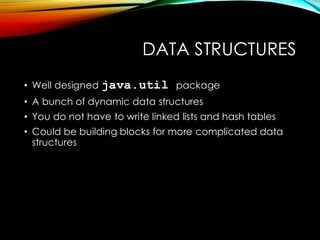


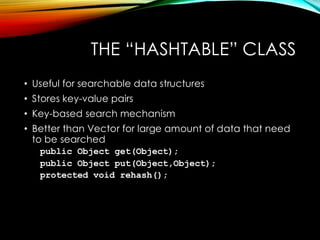









![COLLECTION INTERFACE
public interface Collection {
int size();
boolean isEmpty();
boolean contains(Object element);
Iterator iterator();
Object[] toArray();
Object[] toArray(Object a[]);
}](https://image.slidesharecdn.com/datastructuresinjava-250311020714-f8727f1f/85/Data-Structures-in-Java-and-Introduction-to-Collection-Framework-16-320.jpg)


